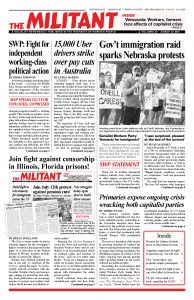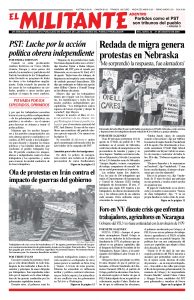The primary contests underway to select candidates for the two main capitalist parties contending in the November elections have been marked by the political crisis wracking both the Democrats and Republicans, a crisis that accelerated with Donald Trump’s 2016 presidential victory.
This crisis is a product of the search by growing numbers of workers for ways to stand up to the bosses’ assaults on wages and working conditions, the debilitating impact on workers of the rulers’ ongoing wars abroad, and the rulers’ grinding attacks on our social, cultural and political rights.
Describing the circumstances that led to Trump’s election in 2016, Socialist Workers Party leader Steve Clark wrote in the introduction to The Clintons’ Anti-Working-Class Record: Why Washington Fears Working People, “Never before have the presidential candidates of both major capitalist parties evoked such political distrust, disgust and aversion among working people, youth and broad layers of the lower middle class.”
As this crisis continues to unfold, the Socialist Workers Party has launched its 2018 campaign, speaking out against the attacks and indignities capitalism is heaping on the backs of the exploited and oppressed in the U.S. and around the world, and offering a road forward for workers and farmers to fight for political power.
Republicans — both those who back Trump and the “Never-Trumpers” who are deeply hostile to the president — hold the House by a majority of 23 seats. The party in the White House has lost seats in the House of Representatives in every first midterm election except once since the Kennedy administration. This reflects how workers’ hopes for some change, as expressed in the 2016 presidential vote, has been dashed time after time. Democrats hope this trend will continue in 2018.
Trump intends to defy that trend, buoyed by the capitalist economic boom underway and steps his administration has taken to end some of the rulers’ ongoing conflicts and wars abroad.
The fact is, Trump isn’t really a Republican. For years he was a New York City Democrat, and his 2016 campaign blasted all the “normal” Republicans of every stripe. At the same time he called for “draining the swamp” of politicians of all parties in Washington.
All five candidates Trump endorsed in the Aug. 7 Republican primaries won their contests. They campaigned as boosters of the president, claiming to be cut from the same mold. He also backed Republican Troy Balderson, who defeated Democrat Danny O’Connor in a special election for a House seat in Ohio. Democrats wrongly anticipated that this would be their first win in a “blue wave” of victories.
Since Trump took office, Democrats have lost eight out of 10 special House elections. Divisions within the Democratic Party have deepened as well since Hillary Clinton stole the 2016 nomination from Bernie Sanders and then lost the election.
Although Democratic Socialists of America’s Alexandria Ocasio-Cortez won the nomination for a New York House district bid in November, and joined Sanders on the stump in the recent primaries, their wing of the party made little headway in those contests. They aim to take over the Democrats and push its reform program to the left of bourgeois politics.
Some Republicans, including John Kasich who Trump defeated in getting the 2016 presidential nomination, are considering whether to stand against him in 2020. Others, including many Never-Trumpers, view him today as unbeatable. Leah Vukmir, who is contesting the Republican nomination for U.S. Senate in Wisconsin, described Trump as “offensive to everyone” in 2016. She now positions herself as one of his most vociferous backers.
The most fervent wish of Democratic liberals is to drive Trump from office, if not into prison. They launched a witch hunt against him and hope to seize control of the House to block his administration from advancing its program, while seeking to impeach him.
The trade union misleaders offer working people no road forward politically, attempting yet again to corral us into backing the Democrats. “We’re setting our sights on November,” Richard Trumka, president of the AFL-CIO union federation, said Aug. 9, urging trade unionists not to stray from the dead-end strategy of focusing their attention and energy on putting more Democrats into office.
The August primary results don’t offer them much hope either.
Crisis of capitalism
Many of the institutions and multilateral alliances that were put in place after the U.S. rulers emerged triumphant out of the second imperialist world slaughter are coming apart today, from NATO to the European Union. Trump is pushing for a series of new one-on-one deals from Korea to Moscow to the Middle East. He has wielded Washington’s military and economic dominance to sanction and bully the rulers there, then offered to sit down and talk, with “no preconditions.”
The White House aims for greater stability and less warfare to gain room for U.S. imperialism. But the administration’s course is unintentionally creating better conditions for working people to organize and press forward our struggles. Tamping down wars and war threats from Afghanistan to Korea to the Middle East is good for the working class.
Such questions are of great interest to workers as we discuss and debate how our class can fight effectively and organize together as part of an international class.
“The Socialist Workers Party is going out to speak with workers all across the country, to pose a working-class alternative to the oppression and exploitation visited on us by the capitalist bosses and their government,” Róger Calero, Socialist Workers Party candidate for governor of New York, told the Militant. “We tell the truth about how the capitalist system works, seeking to pit workers against each other as they profit from our labor.
“Workers need our own party, one that speaks in defense of all those who are trampled on by the dog-eat-dog workings of capitalism. We need to look to each other,” Calero said, “to fight to unify the working class and fight to take power into our own hands.”

